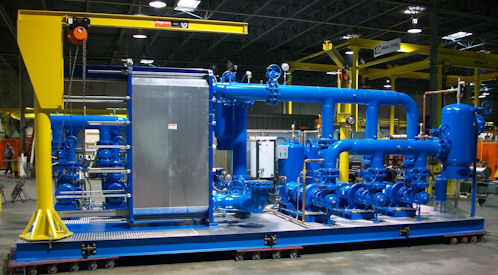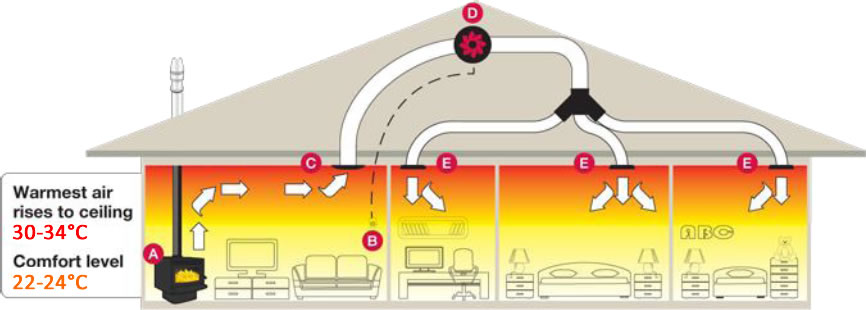Top 10 Thermal Innovations Driving DVS Heat Transfer Systems Forward
Wiki Article
The Role of Heat Transfer Solutions in Sustainable Energy Solutions for the Future
Heat transfer systems are essential in the pursuit for lasting power solutions. They enhance thermal power management, enhancing the performance of eco-friendly innovations. By utilizing devices like transmission, convection, and radiation, these systems minimize power losses. Their function in solar thermal and geothermal applications is specifically considerable. As advancements arise, the possibility for more innovations raises vital questions concerning future power techniques. What developments will shape the landscape of sustainable energy?Recognizing Heat Transfer Equipments

The Importance of Thermal Energy Management
Effective thermal energy management is necessary for maximizing power efficiency and minimizing waste in various systems. By regulating temperature and enhancing Heat transfer processes, companies can substantially decrease power consumption and functional expenses. Reliable administration entails the implementation of advanced technologies and methods that check and control thermal conditions within systems, guaranteeing that power resources are utilized effectively. Furthermore, correct thermal power monitoring contributes to decreasing greenhouse gas discharges, straightening with international sustainability goals. It also boosts system dependability and performance, causing enhanced item quality and longer equipment life expectancy. Eventually, prioritizing thermal power administration is an important step in the direction of developing a lot more lasting energy options and promoting a responsible technique to energy intake in domestic and commercial contexts.Applications of Heat Transfer in Renewable Power
While various renewable energy sources promise sustainability, the efficient application of Heat transfer plays an important function in their efficiency. In wind energy systems, Heat transfer is utilized for turbine part cooling, improving performance and durability. Geothermal energy depends on reliable Heat exchange between the planet's subsurface and the fluid flowing in the system, optimizing energy removal. Biomass energy processes additionally benefit from Heat transfer, as it assists in converting organic materials right into usable gas with pyrolysis and gasification. Additionally, in hydropower, preserving perfect temperatures in tanks can boost energy output. Each of these applications demonstrates the critical significance of Heat transfer systems in enhancing renewable energy innovations, inevitably adding to a much more lasting energy future.Enhancing Solar Thermal Power Performance
As solar thermal power systems proceed to evolve, enhancing their effectiveness has actually ended up being crucial for making best use of power output. Breakthroughs in Heat transfer modern technologies, such as enhanced thermal storage products and cutting-edge Heat exchangers, play a significant role in improving performance. By using advanced materials that have exceptional thermal conductivity, systems can transfer and catch Heat much more properly. In addition, incorporating radar that follow the sunlight's course assurances that collection agencies obtain perfect solar exposure throughout the day. Making use of nanotechnology in solar absorbers can even more increase power absorption prices. Moreover, incorporating automated control systems assists manage temperature levels and take care of power distribution efficiently, leading to minimized losses and enhanced overall system efficiency. These improvements lead the method for more sustainable solar thermal power solutions in the future.Geothermal Home Heating: A Sustainable Service
Geothermal heating offers a practical option for sustainable energy, providing substantial environmental benefits through decreased greenhouse gas discharges. Its performance and cost-effectiveness make it an eye-catching option to conventional heating unit. Difficulties associated to implementation should be addressed to maximize its prospective impact.Environmental Advantages of Geothermal
Typical heating methods add considerably to greenhouse gas discharges, geothermal home heating offers a compelling choice that minimizes ecological impact. By utilizing the Earth's inner Heat, geothermal systems make use of a sustainable power source, substantially reducing reliance on fossil fuels. This method generates marginal carbon emissions, making it a cleaner choice for domestic and industrial heating. Additionally, geothermal systems advertise power efficiency, as they call for less energy contrasted to standard heater. DVS Heat Transfer Systems. The use of geothermal energy also aids in reducing air pollution, boosting local air quality and public wellness. As a lasting solution, geothermal heating supports climate modification reduction efforts, placing itself as a crucial element in the shift towards a greener futurePerformance and Cost-Effectiveness
Exactly how does geothermal heating measure up in regards to performance and cost-effectiveness compared to typical heating systems? Geothermal heating demonstrates premium effectiveness, typically accomplishing a coefficient of performance (POLICE) of 3 to 5, suggesting it creates three to five devices of Heat for each unit of electricity consumed. This performance equates into lower operating prices, especially in areas with stable geothermal resources. Initial setup prices can be more than standard systems; nonetheless, long-lasting financial savings on energy costs and minimized upkeep costs can counter these in advance financial investments. Furthermore, many governments incentivize geothermal systems with refunds and tax credit reports, enhancing their cost-effectiveness. Generally, geothermal home heating becomes a sustainable and financially feasible alternative to more conventional heating services.Implementation Challenges and Solutions
Numerous difficulties can restrain the prevalent application of geothermal home heating systems, in spite of their clear advantages as a sustainable power remedy. High preliminary installation prices typically prevent investors and property owners, making funding a considerable obstacle. Furthermore, the geographical limitations of ideal geothermal sites limit access in particular areas. Local guidelines and allowing processes can also complicate project growth, leading to delays. Public recognition and understanding of geothermal systems remain low, preventing acceptance. To attend to these challenges, targeted education campaigns can enhance open secret, while government rewards could minimize economic worries. Working together with neighborhood authorities to streamline regulations might facilitate smoother job approvals, ultimately advertising the fostering of geothermal home heating as a feasible, sustainable energy option.Technologies in Heat Transfer Technologies
Innovations in Heat transfer technologies play an important duty in improving power effectiveness and sustainability. Advanced Heat exchangers and phase modification products are at the center of these advancements, supplying significant enhancements in thermal monitoring. These modern technologies not only optimize power usage but also add to reducing environmental impact in different applications.Advanced Heat Exchangers
Advanced Heat exchangers play a necessary duty in boosting power efficiency across different applications in lasting energy services. These tools assist in the transfer of Heat between 2 or even more fluids, significantly decreasing energy usage in processes such as commercial home heating, air conditioning, and power generation. Technologies in products and design, such as making use of nanofluids and compact configurations, have led to moved here improved thermal performance and reduced dimension requirements. Additionally, improvements in digital tracking and control systems permit optimized operation, more increasing effectiveness. By minimizing waste Heat and taking full advantage of power recovery, advanced Heat exchangers add to lower carbon footprints and support the shift toward eco pleasant innovations. Their continued development is essential for accomplishing worldwide energy sustainability objectives.
Stage Modification Materials
The assimilation of phase adjustment products (PCMs) right into Heat transfer innovations stands for a substantial innovation in energy administration and performance. PCMs absorb and launch thermal power throughout their phase changes, enabling reliable temperature level guideline in building his response products and power systems. By saving excess Heat throughout peak durations and launching it when demand boosts, PCMs add to pack shifting and power preservation - DVS Heat Transfer Systems. This capacity enhances the efficiency of renewable resource systems, especially in solar thermal applications. In addition, PCMs can enhance the thermal convenience of indoor environments, minimizing dependence on conventional heating and cooling methods. As innovations in PCM solutions remain to emerge, their function in sustainable power services is positioned to grow, supplying encouraging methods for future research and application
Future Potential Customers for Heat Transfer in Sustainable Power
As the demand for sustainable energy remedies proceeds to rise, the role of Heat transfer systems is coming to be increasingly vital in shaping future modern technologies. Innovations in designs and products are expected to boost performance in Heat transfer, lowering power losses in different applications. The integration of advanced thermal storage space systems, such as phase modification products and thermochemical storage space, will allow much better administration of power resources. Study right into nanofluids and biomimetic Heat exchangers might further optimize thermal performance. The fostering of smart innovations will certainly enable for real-time monitoring and adaptive control of Heat transfer procedures. These advancements are poised to greatly contribute to the general effectiveness and sustainability of power systems, paving the means for an extra energy-efficient future.Often Asked Questions
How Can Individuals Execute Heat Transfer Equipment in your home?

People can carry out Heat transfer systems in your home by setting up energy-efficient home appliances, using radiant heat, and maximizing insulation. These actions boost energy efficiency, reduce prices, and promote sustainable methods in household settings.

What Are the Costs Connected With Mounting Heat Transfer Systems?
The expenses linked with installing Heat transfer systems differ widely, generally including equipment, installation labor, and maintenance. Aspects such as system type, home size, and local laws go to this site considerably affect the general expenditure involved.Exist Federal Government Incentives for Heat Transfer System Installations?
Government rewards for Heat transfer system installments vary by region and can consist of tax obligation grants, debts, and refunds. These monetary advantages aim to urge adoption, eventually advertising energy performance and minimizing environmental influence within areas.Exactly How Do Heat Transfer Systems Influence Energy Bills?
Heat transfer systems significantly affect energy costs by enhancing energy effectiveness. By improving the transfer of Heat, these systems reduce power consumption, bring about lower energy costs and producing a much more lasting method to power management.What Maintenance Is Needed for Heat Transfer Solutions?
Maintenance for Heat transfer systems includes routine assessments, cleaning of parts, checking liquid degrees, guaranteeing correct insulation, and replacing worn parts. These jobs aid maintain effectiveness, protect against breakdowns, and lengthen the system's functional lifespan.These systems assist in the motion of thermal power from one tool to another, allowing the transfer of Heat for air conditioning, heating, or energy generation functions. Geothermal power counts on reliable Heat exchange in between the earth's subsurface and the fluid flowing in the system, taking full advantage of power extraction. Furthermore, geothermal systems advertise power effectiveness, as they call for much less power contrasted to standard home heating systems. Advanced Heat exchangers play an essential role in enhancing power effectiveness across numerous applications in sustainable power remedies. Heat transfer systems especially affect power bills by maximizing power performance.
Report this wiki page